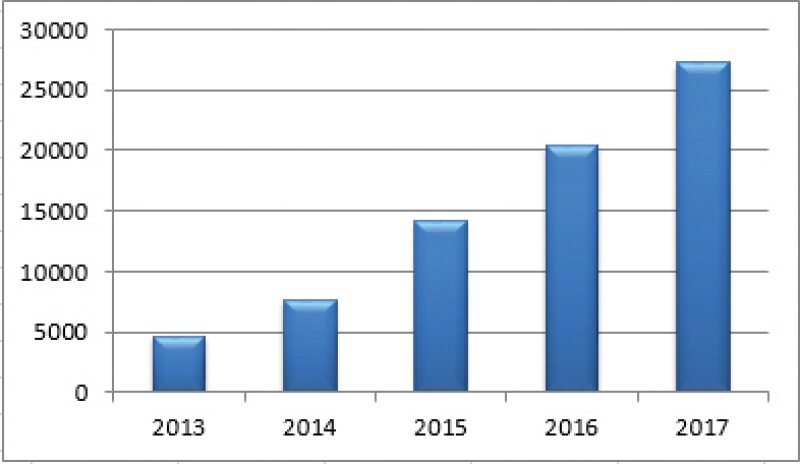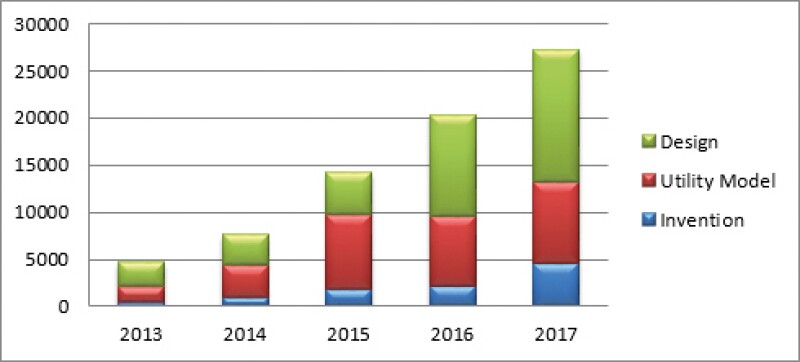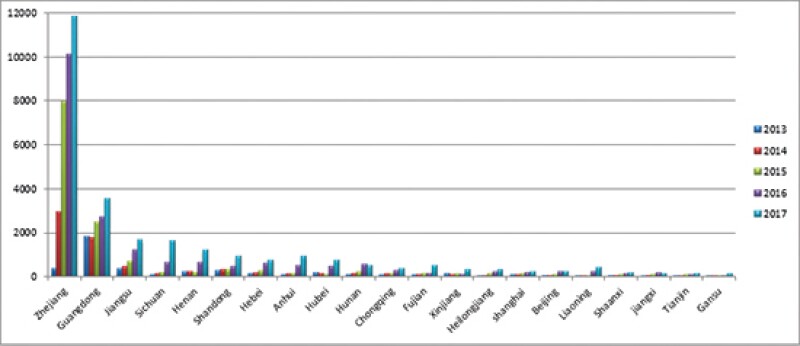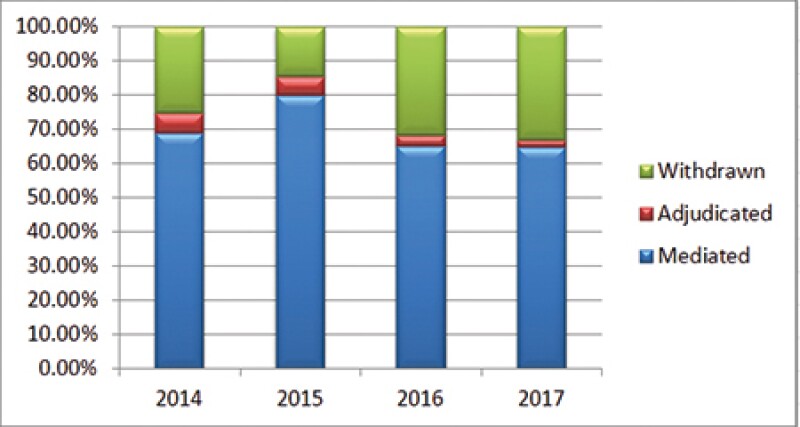
With the adoption of the Belt and Road Initiative (BRI) inaugurated by President Xi five years ago, trade and investment between China and its BRI partners have greatly increased. Meanwhile, the Chinese government has been more determined to create a benign business and innovation environment with regard to intellectual property for both domestic and foreign participants. The recently passed Amendments to the Patent Law of the People's Republic of China (Draft) (hereafter called the Amendments) reflect a trend of strict protection against patent infringement. One of the highlighted possible changes relates to an increased emphasis on administrative enforcement in addition to judicial enforcement.
In this article, we provide an overview of administrative enforcement for patent infringement disputes in China and a closer look at current and possible changes resulting from governmental reorganisation and legislative reform. We also discuss the concerns that a patent owner may have in relation to administrative enforcement based on some official statistics and cases in recent years, from a practical perspective. This article in no ways intends to conclude that administrative enforcement is not as effective as judicial enforcement, but hopefully provides some useful insights for patent owners so that they are well-prepared should they decide to follow the administrative route.
Overview of patent administrative enforcement in China
The Patent Law of China provides that a patent owner facing a patent infringement action may seek remedies judicially or administratively. Much like in the judicial approach, by filing a complaint to the administrative authority, the patent owner should be aware of the risk of triggering an invalidation challenge which is the most common way of defending an action.
Administrative enforcement is free to request, and has a short time limit of three months. An extension of one month is allowed for extremely complicated cases. Unlike judicial enforcement, the administrative authority may start an ex-officio investigation on its own initiative. This may seem ideal for patent owners who are short of funds and resources or incapable of gathering evidence personally, but there are still occasional complaints that the power of the administrative authority during investigation is not as strong as expected. In the case of exhibitions or trade shows which last for a short time, administrative authorities may act faster so that evidence is preserved. These features may account for the increasing number of cases seeking administrative enforcement (see Fig. 1).
Fig. 1 Number of administrative enforcement cases accepted in years 2013-2017

Through administrative enforcement, patent owners may seek injunctive relief and mediation but should bear in mind that no monetary relief can be granted at present. The administrative authorities may mediate on the compensation caused by the infringement upon request. If the mediation fails, the patent owners may still file a civil lawsuit to the court which will consider the findings obtained and recognised by the authorities during investigation.
Administrative protection may not be the best approach when a high damages award is the primary goal of enforcement.
Statistics also show that cases filed by patent owners from countries or regions other than mainland China constitute only a small part of the total amount, for example, 8.51% in 2017. Factors, such as knowledge and confidence in the administrative enforcement system in China, ideological differences, available funds, and familiarity with administrative working style, may account for this huge contrast between domestic and foreign patent owners.
Reform of administrative enforcement for patent infringement: current changes and trends
Reorganisation of administrative bodies
In March 2018, the 13th National People's Congress approved the proposal for reorganising the administrative bodies under the State Council. The State Intellectual Property Office (SIPO), which was affiliated to the State Council, is now governed by a new body called the State Administration for Market Regulation (SAMR) and is renamed the China National Intellectual Property Administration (CNIPA). The CNIPA also oversees matters related to trademarks and geographical indications (except copyright at present). The previous local intellectual property offices are also correspondingly governed by the local administrations for market regulation.
The SAMR was authorised to organise and direct the administrative enforcement power for patent infringement, with the responsibility for supervising and governing the market order. The SAMR's establishment and its authorisation for administrative enforcement of patents, as well as the reorganisation of the CNIPA are considered a sign that administrative protection for intellectual property is strengthening. It is expected that IP disputes will be better coordinated and handled by one administrative body.
Trends showing the power of administrative enforcement in patent infringement cases
The Amendments proposed to expand the authority of administrative enforcement for patent infringement (Article 69) and the jurisdiction of the CNIPA over patent infringement cases of significant influence (Article 70).
Practical issues patent owners may face
Limited expertise and experience for handling complicated patent infringement disputes
A matter of concern is whether the qualification requirement for administrative officials matches the skills necessary to deal with patent infringement disputes. Currently, officials are required to obtain a so-called administrative law enforcement certificate before they are eligible to handle disputes.
Considering that patents are always technical and can be very complicated to understand, such a legal qualification may not closely correlate with the skill required to handle technical disputes. The statistics from years 2013-2017 (see Fig. 2) indicate that utility model patents and in particular design patents constitute a major part of disputes handled by administrative enforcement. This shows that patent owners are more likely to consider administrative enforcement for dispute resolution in cases that have less room for argument, or cases in which it is easier or more straightforward to evaluate validity or prove infringement.
Fig. 2 Number of administrative enforcement cases categorised by types of patents in years 2013-2017

For extremely complicated cases, deployment of officials and other resources might be inevitable. The procedures are often complicated and involve different parties, and require a certain set of provisions to define and clarify.
Xixia Longcheng v Yulin Intellectual Property Office (IPO) is an example that reveals the inability of the local administrative authority to deal with complicated patent infringement disputes and its failure to follow a strict procedure, leading to long-lasting legal proceedings. In this case, Yulin IPO invited an officer from another jurisdiction to assist in hearing the case due to lack of expertise. The Supreme Court found that Yulin IPO erred firstly because it lacked the necessary procedure to incorporate that officer into the panel, and secondly because the officer attending the hearing was not the one issuing the adjudication.
Regional differences
The extent to which regional difference may affect the outcome of administrative enforcement cases should also be considered.
The distribution of patent infringement cases seeking administrative enforcement indicates that administrative authorities from different jurisdictions have varying degrees of exposure to handling these cases (see Fig. 3). Due to business activities and the density of manufacturers as well as distribution channels, some areas–such as the provinces of Zhejiang, Guangdong and Jiangsu–may have more demand for administrative dispute resolution, while others struggle to reach the same number of cases each year. The popularity reflects the likelihood that authorities in high-demand areas have plenty of experience, expertise and resources to rely on, making them more competent.
Fig. 3 Number of administrative enforcement cases categorised by province in years 2013-2017

On the other hand, in remote or economically inactive areas, a practical issue of local protectionism, caused by, for example, the pressures of employment, tax and local relationships, might somehow affect the independence of the administrative authorities. In the past, local administrative authorities were actually local intellectual properties offices subordinate to local governments. That is, they could be guided by SIPO regarding how to handle a case appropriately but did not necessarily follow the guidance. It has only been one year since the new reorganisation took place, making it too early to comment on the effect of this change. However, the determination to improve IP protection and current legal landscape in China shows a maturing IP administrative enforcement system with enhanced independence and increasing experience. We therefore expect there will be some positive changes.
Involvement of administrative authority in investigation and disputes resolution
How much the administrative authorities are involved in the process of handling disputes will greatly affect the efficiency of administrative enforcement.
Patent owners consider the actions of the authorities during investigation – in particular on-site inspection, seizure of products accused of infringement, and infringement inquiries and investigations etc.– as being significant and having an adverse effect on the efficiency of administrative enforcement if absent. The Amendments are a sign of hope, clarifying the authorised actions that the authority can take during investigation. Such actions include querying the parties, and investigating the circumstances related to the suspected illegal act; on-site inspection; reviewing and reproducing the relevant documents; and examination of the products relevant to the suspected illegal act. The other positive possible change may be that cases that are of nationwide significance may be handled by the national patent administrative department upon request. However, the criteria of nationwide significance and more details regarding how the request will proceed are still uncertain at this stage.
We can gain some insight into the preferred way of involvement of the authorities in a dispute resolution by studying the manner of closing a case. Statistics from the years 2014-2017 indicate that mediation is the prevailing method adopted in patent administrative enforcement cases (see Fig. 4). This is not surprising considering that administrative authorities still have other duties other than handling patent infringement disputes so they may have limited resources and a tight schedule. Particularly for cases that are complicated or have a social influence, mediating instead of adjudicating may avoid an improper or incorrect decision.
Fig. 4 Percentage of administrative enforcement cases categorised by way of closing in years 2014-2017

Execution of administrative decision or the settlement agreement
If there is a finding of infringement, the administrative authority will issue a decision which has a very limited deterrent effect due to its administrative nature. For the most part, the infringer executing the decision cannot be counted on. Again, due to the administrative nature of the decision, normally the patent owner cannot apply to the court for mandatory execution directly but has to request the authority issuing the decision to do so. If the authority has not applied for mandatory execution after a time limit, the patent owner then has the right to directly apply to the court. Essentially, the patent owner has to expect a delay in execution even he has obtained a favourable decision.
For cases closed by way of mediation, the settlement agreement achieved between the patent owner and the accused infringer is actually a contract and thus is not mandatorily executable. Unfortunately, the patent owner can only file a civil lawsuit to enforce the agreement under contract law.
The administrative enforcement system in China has matured rapidly. An increasing number of patent owners consider an administrative approach as an option when formulating an enforcement strategy. In spite of the determination of the government and visible improvements, patent owners should take practical issues into consideration when choosing this method of enforcement. The system is still in the process of creating a comprehensive framework in order to fill in the gaps. Administrative enforcement is often affected by factors such as experience and expertise as well as the social and economic influence of the parties. Ignoring these issues may lead to complications, delay and increased costs. An optimum strategy is one that best coordinates the goal of enforcement with the objectives and resources of patent owners. For cases which are straightforward to prove infringement, cases in which patent owners have a tight budget or seek a quick removal of the infringers from the market rather than considerable damages, or cases in a jurisdiction with plenty of experience in patent administrative enforcement, the administrative approach is worth considering.
Hua Tan |
||

|
|
Ms Tan began her legal career in patent law and joined Liu Shen & Associates in 2011. Ms Tan obtained the qualification of patent attorney in 2012 and qualified as a lawyer in 2017. Her current practice mainly focuses on patent prosecution, re-examination, patent validation and litigation in the technical field of mechanical engineering, automotive engineering, daily necessities, and medical devices. Her services also include providing opinions and strategy consultations for corporations, and providing legal advice. She obtained her bachelor’s degree in mechanics and master’s degree in fluid mechanics from Peking University. Before joining Liu Shen, Ms Tan used to work as a researcher on natural language processing and information retrieval, specialising in algorithm study on multi-language segmentation, automatic summarisation, keyword extraction, named entity recognition, language models, character encoding techniques and recommendation systems. |
Qian Hao |
||

|
|
Ms Hao joined Liu, Shen & Associates in 2008. She qualified as a patent agent in 2009 and a lawyer in 2010. Her practice involves patent prosecution in a variety of fields with a focus on mechanical technologies, in particular in the areas of vehicle engineering, medical devices, energy, sportswear and equipment, musical instruments, home appliances and daily necessities. She is also involved in patent re-examination, invalidation, IP infringement litigation and strategic counselling. She regularly advises clients ranging from individual inventors to large, established corporations on matters relating to patent prosecution, patent validity, infringement and enforcement. Before joining the firm, Ms Hao obtained her bachelor’s degree in mechanical engineering and master’s degree in material science and engineering both from Tsinghua University, China. She gained extensive experience in mechanical design and material processing while working as a graduate research assistant at Tsinghua University in collaboration with Mitsubishi Heavy Industries, Japan. Ms Hao also has an LLM degree in international business law from York University, Canada. |











